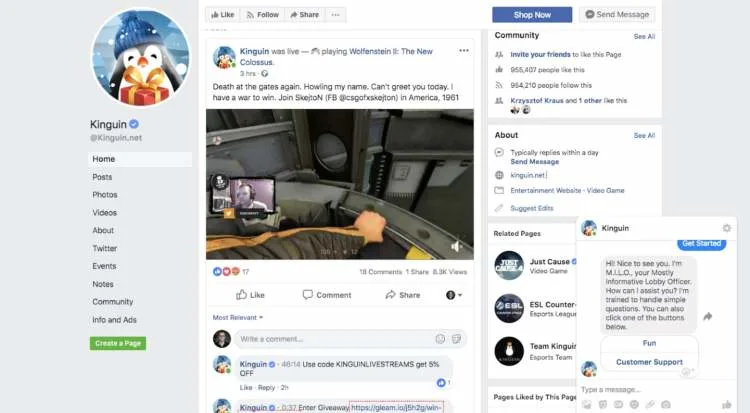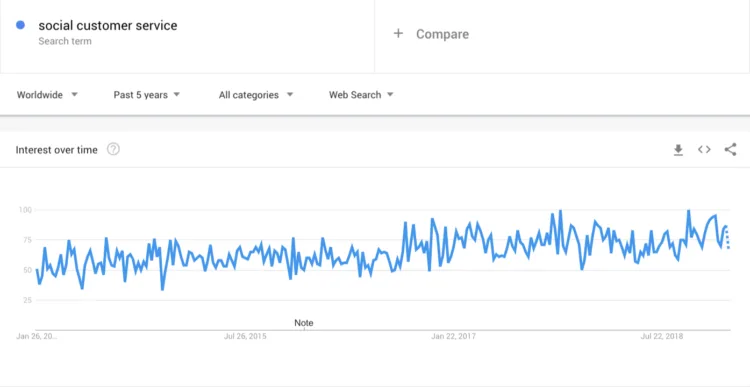How to Do Social Media Customer Service the Right Way

Before the internet, a telephone call was the fastest and most effective method customers used to seek help from companies.
Telephone calls had already beaten the postal service as the quickest customer service channel.
They called it snail mail for a reason, after all.
Then came email, and the internet became the new home for rapid customer service.
You could say that email killed the telephone call… but then social media killed email.
Once we got used to email, social media interactions changed the game.
With social media, you can connect in real time, up to the second, with anyone. That’s the new wave in forward thinking customer service!
Social media customer service takes advantage of the instant feedback mechanisms and support for photos, videos or other media in established social media platforms.
Moreover, social media is a familiar environment that customers frequently use for many other activities, including interactions with brands they love.
Therefore, it only makes sense that they find it a valuable platform to raise their issues to be resolved by companies.
These stats show why social media customer care is so critical:
1 in 3 social media users would rather have social media customer care services than telephone or email.
75% of people will likely post something positive about your brand if you make meaningful social media connections.
If you give a positive social media customer service experience, 71% of your consumers will likely recommend your brand to others.
Customers will spend 20-40% more if you engage and respond to them through social media.
About 67% of consumers are seeking resolutions for issues through Twitter, Facebook and other social media networks.
What is Social Media Customer Service?
Social media customer service is an organized system of providing customer support through social media platforms.
It’s a critical and rapidly growing contact channel within the entire customer service ecosystem, complementing call-based customer service.
It covers support services before, during and after purchase.
It also involves activities like addressing complaints, providing guidance, answering questions, or issuing refunds.
Ultimately, the primary goal is to give clients an easy and enjoyable customer experience, which helps retain and grow your business.
Social customer service may be handled by a dedicated social media support team or by the call center team.
For effective social customer service, companies utilize specialized training, workflows and software to resolve customer issues.
Major social media platforms also facilitate such customer service operations.
Since it’s a preferred mode for issue resolution by many customers, effective customer service will meet your customers’ needs and even give your company a competitive edge.
However, you need to manage the unique complexities of this support channel including regulatory concerns about sharing private information, preserving your brand image in public engagement and achieving optimum response rates.
Creating Your Social Customer Service Strategy
You need an overall social customer service strategy before you incorporate social channels into your existing customer service operations.
Considering that 63% of successful companies align all their business units to the overall corporate strategy, that’s the only way to ensure effective and efficient implementation.
A comprehensive social media strategy should feature these 6 key components for customer service:
1. Set up brand monitoring.
The first step is setting up an active brand monitoring system within the social media platforms your customers use to reach out to you.
You can do this conveniently using social media tools.
Customize the brand monitoring tools with streams to identify and list posts and comments with specific words.
This helps you quickly narrow down to the most relevant content.
For instance, you can set up a stream for any mention of your brand with positive or negative words.
To pick out questions, set up a stream for content with your brand name and a question mark.
Having various streams helps you segment customer concerns so you can prioritize urgent issues.
Real-life example
Let’s say you run an ecommerce store that sells jewellery.
Your customers are likely writing about your brand in social media, not necessarily tagging your company.
Your customers might be complaining about your product without you being aware of that.
Use social media monitoring tools like Mention or Brand24 to monitor keywords mentioned online and get notified whenever somebody mentions your brand online.
Use tools to help monitor
I use a service called Gorgias which allows me to monitor and respond to messages on all social media platforms including email on a single interface.
In addition, all order information can be found on the same screen, so I don’t have to pull up my shopping cart.
– Steve Chou, Founder, MyWifeQuitHerJob
2. Determine what types of comments get responses.
Obviously, you won’t respond only to positive comments while disregarding negative ones.
Sometimes the way you manage a negative comment can actually win over new customers.
However, since social media isn’t really a dedicated customer support platform, you’ll get many more comments beyond what your customer support team should handle.
Ideally, you want to avoid your social support team getting dragged into conversations unrelated to your business, but still maintain reasonable engagement with your customers.
Above all, avoid feeding the trolls.
To manage this, create a priority list so your team can give extra attention to the most urgent and critical issues.
Train all team members on how to handle both positive and negative comments and give clear guidelines on what to say when they do respond.
Real-life example
If you get a lot of queries and comments on social media and have a large customer support team in place, it might be problematic to manage all the guidelines and resources.
You can easily use tools like Knowledgebase.ai to structure knowledge within your business and provide easy guidelines for your customer support.
Cultivate a Community
The need for social media customer service can be mitigated by customer Q&A on your website.
That said, engagement of any kind on social media can help take the temperature of brand sentiment, find and cultivate potential brand ambassadors and remedy disenchanted customers before they create a ‘social problem.’
– Gene Ferriter, Solution Specialist, Plumtree Group
3. Build a system to get questions answered quickly.
With how fast the internet is, a late answer can be as bad as no answer at all.
Your goal should be to get questions answered as soon as customers ask them.
This requires a carefully organized system with dedicated social customer care members.
Segment responsibilities across different social networks and ensure there’s a clear process for how every issue is investigated and replied to.
Set up a system that unifies all customer issues in one place and assigns specific messages to particular team members.
This enhances the efficiency and speed of resolving customer issues, unlike having to manage multiple social media platforms.
Real-life example
The larger your store gets, the more questions and requests you’ll receive from your customers.
With time, it will become more and more difficult to handle more queries, and you might consider using a helpdesk software to manage your business even better.
Develop an FAQ
It can get pretty easy to get overwhelmed when it comes to replying to customers on social media.
The number one tip I have is to develop an FAQ, whether that exists on your website or in your notes folder on your desktop.
Being able to have canned responses that you can point to or copy and paste will help manage the work you have to do when replying, and also show that you’ve put some thought into these frequently asked questions.
Additionally, using their name goes a long way, too.
I always feel better served when someone takes the time to respond and simply uses my name in the response. It shows they’re taking the time to at least read my name and acknowledge I’m a human!
– Shayda Torabi, Owner, WithShayda, Co-Founder, restartcbd
4. Consider having a dedicated support channel.
Apart from having a dedicated social customer support team, you can have a dedicated customer support channel within the social media platforms.
In your social media accounts, direct customers who need assistance to your support profile.
This will reduce the challenge of tracking specific customer queries and also provide a reference platform where customers can evaluate past queries similar to theirs.
Most of all, a separate support channel will help segment your social media content marketing efforts and customer services.
Real-life example
Each of your customers might prefer different support channel but unless you own a very small ecommerce store, it will be difficult for you to handle queries coming from multiple channels.
You can set up a quick and easy-to-use customer support channel like LiveChat with its built-in ticketing system to make sure your team handles customer queries easily and effectively.
Your brand needs to be a social guru (and so do you!)
Be a social guru. Make sure your brand is set up and using the following: Twitter, Facebook and Instagram.
If you have a social strategy and are implementing it, kudos to you, but if you don’t, at the very least you can use these social channels to give updates and superb customer service.
Chatbots are the future.
If you’re not using them, you should. Through Facebook and Twitter, you can set up auto-responses that will give your customer an immediate answer.
In most cases, chatbots can answer their question, so the customer can move on to purchasing the product.
The best part is you don’t have to do anything but set them up and let them run.
If you’re a service provider, we also recommend using Twitter and Facebook as your notification system.
If you have a new release, an outage or a new how-to tutorial, there is no faster or quicker way for your customer to gain this knowledge then through a tweet or a posting.
– Elyse Smith, Project Manager, DigitlHaus Agency
5. Have internal best practices for responses.
Customer support isn’t just about solving customer issues.
It’s a key tool in building your brand image.
To achieve this, you need internal best practices that ensure your support team delights customers beyond solving their problems.
Best practices ensure your customer service appears not only professional but also friendly and approachable.
Above all, your responses will be consistent regardless of the type of client you’re dealing with.
Clear guidelines prevent intentional or accidental bias in your teams’ responses, which can give your company a bad impression.
Real-life example
Your communication with clients acts as a great base for optimizing your customer support.
Analyze the data of your conversations and use it to create your support best practices.
You can even use a conversational bot with software like ChatBot to automate the most frequently used answers.
Involve the entire organization.
I would recommend involving all of your employees in improving customer engagement and service via your social media channels.
Instead of having just one or two people responsible for handling your social media channels, why not use the entire workforce?
Develop a culture where employees act as brand advocates and respond to or comment on posts/queries related to your brand.
You can even ask some of your employees to handle your social media platforms on a rotational basis.
This will not only improve customer service, but will also help with employee engagement.
– Shane Barker, Digital Strategist, Shane Barker Consulting
6. Determine how you will measure and report on your efforts.
Reporting and measuring your social customer service activities are essential to gauging your performance.
Identify and measure Key Performance Indicators (KPI) like first contact resolution, resolved issues, response rate, complaint escalation rate, and customer retention.
Also, record qualitative feedback in a document format that’s convenient to analyze.
Customer satisfaction surveys will also help you to gauge your customer service performance.
The data you collect and findings you make can direct your efforts in specific areas that need greater attention. Perhaps, you might find that you need more staff at particular times compared to others, based on the flow of customer queries.
Real-life example
The more customer support cases you handle, the larger the amount of data you collect.
Use this data to improve the quality of your support and, in turn, grow your sales.
You can use software like Promoter.io or Survicate to help you collect feedback from your customers.
Focus on Lifetime Value
Communication. It’s what marketing is all about, and a negative experience can explode on social media.
Respond quickly, with empathy, and with the aim of resolving the issue.
If brands have a community on social media then the users and customers will want to return and buy again, otherwise why are they following the brand on social?
Therefore think LTV and know that by keeping social media followers happy, merchants can increase their customers’ LTV.
– Luigi Moccia, Founder, Calashock
Best Practices for Social Media Customer Service
Social media isn’t just cat videos and funny memes.
If you do it right, you’ll own your narrative and customers will love interacting with you and sharing what you’re doing.
But to do it right, you need to set aside a plan for every move you make.
Best practices are the backbone of this. They’re vital in achieving maximum benefits from your social media customer service.
You’ll also avoid the adverse effects of poor implementation.
For instance, merely ignoring social media support requests produces a 15% higher average churn rate compared to companies who respond to support requests.
Therefore, you should apply these best practices in social media customer service.
1. Responding quickly is key.
Fast response can never be overemphasized.
Have you ever asked a question and not heard an answer back in a timely manner? Imagine if you’re a frustrated consumer online doing the same and expecting 24/7 support. You want your answer now.
Your business will gain 3 – 20% greater customer spending per interaction if you quickly respond to and resolve customer issues without redirecting to other channels.
Simply put, customers expect almost immediate responses through social media.
You can only achieve this with a dedicated social customer service team and an effective social customer service strategy.
An ideal response time is less than 60 minutes, which is the expectation of 42% of consumers. If that’s not possible, post hours when someone will be available for immediate response. You can even include possible options like your resource page for customers who want fast answers.
Quickly and politely
Respond quickly and politely, even if it’s someone complaining.
It takes so little effort to just respond… but so few brands do it.
If it keeps you so busy that you’re not getting more important things done, then hire someone to help out.
– Brandon Jones, Business Unit Director, Salted Stone
2. Be transparent.
Just because your response time should be fast, it doesn’t necessarily mean you can fix all customer issues fast.
Instead of giving false promises, you should clearly explain to customers how long it will take to resolve their issues—even if it means revealing that you don’t know how long it will take.
Your customers will be far more disappointed if you don’t deliver on an ill-conceived promise, than having to wait.
They will actually appreciate your honesty.
To help customers understand why resolving their issues will take longer, provide brief details of what you’re doing.
Consider indicating that you’ll file a ticket with the product team or escalate the issue to higher-ranking personnel.
Greater transparency will assure customers of your commitment to resolving their issues.
3. Know which social media posts should be resolved in public or private.
Depending on the information involved, specific issues must be resolved in private.
You can quickly identify an issue that will require private resolution if the process of resolving it will require personal information.
Therefore, your team should always note such instances beforehand and invite customers to send the necessary personal details through direct message or email.
In some instances, conversations that are typically handled publicly can get tense. To avoid public altercations, direct the customer to private engagement.
A private conversation can be resolved conclusively since customers have the necessary privacy to present all the details of their case.
4. Respond to all social media feedback, questions and comments.
If you don’t respond to any one of your customers’ issues, you might never have a second opportunity to do so.
More than half (58%) of customers will never deal with companies giving poor customer service.
Besides, such people can leave bad reviews, which will make your company look bad for potential new business.
You must respond to all feedback, questions and comments on social media. Monitor all of your mentions, check your direct messages (DMs), review your reviews and keep tabs on any place you find people talking about you.
Respond to everything, whether that involves admitting to your mistakes or simply appreciating a customer for commenting.
Responding quickly to client queries builds your engagement on social media and gives you a high average response time.
5. If possible, use a person’s first name and don’t sound too scripted.
Using people’s names is a powerful way of personalizing your response to each client.
It shows you care enough to find out who the client is, even if it took you only a few seconds to identify the client’s name.
Complement this with customer service team members signing off responses with their names.
It humanizes the conversation, assuring customers that they are talking to human beings who can empathize with their problems – not just an inanimate company or machine or AI.
Make sure to indicate each team member’s working hours, so customers know when they can reach specific personnel (some customers may develop a preference for specific customer service team members).
Even when you have to use canned responses, spice them up with a few words or phrases that add personality and convey empathy.
The last thing you want is a conversation that sounds scripted.
You want every customer to feel special and appreciated. Canned responses won’t achieve that—genuine human interaction will.
6. Always respond positively.
Customers with queries may be disappointed and frustrated.
Keeping your responses light and positive helps drive conversations towards a fulfilling resolution instead of further frustration.
Remember, you’re not just handling customers’ rational issues, but also dealing with their accompanying emotional state.
However, how light-hearted your responses are depends on the tone of your customers’ query.
If a customer uses a causal, humorous tone, reflect the same in your response.
If the customers’ tone is formal, your best bet is to use a similar tone in your response.
7. Avoid the Streisand Effect.
The Streisand effect is when a defensive reaction to hide, remove and censor information or otherwise take action against your critics backfires and further publicizes the information.
To avoid this, don’t argue with customers online.
Train your support team not to settle scores, but seek mutually beneficial solutions. They should see themselves more like referees than opposing team players.
Above all, avoid threatening your online customers even when they leave negative reviews that you feel aren’t justified.
Facebook Customer Service
Of all the social media sites, Facebook has the greatest proportion (82%) of consumers who want to get customer service through the platform.
Fortunately, the site has special features to display your customer service focus.
A prominent feature is your company’s Facebook support response time rate, which is placed on your Facebook page.
You can also link your page to a Facebook group.
You can also use various apps for customer service, including: Contact us, FAQ, feedback, track your order and technical support apps.
Using Facebook Messenger for Customer Service
Facebook Messenger facilitates automation of your customer service, among several valuable features.
1. Messenger bots.
Programmable messenger bots radically automate simple customer service queries.
They limit human intervention to only complex support services, further reducing customer service costs.
2. Enable transactions.
You can take orders, book appointments or receive payments right in Facebook Messenger.
Apart from making it easy for customers to buy your products, it also creates an opportunity to sell exclusive products within Messenger.
Twitter Customer Service
On Twitter, 53% of customers expect a response within one hour.
To achieve this, configure your profile by:
Displaying your support hours for customers to know when to contact you.
Turning on the “support” option to show that you’re customer-service friendly.
Enabling direct messages to handle complex or private issues.
Social Customer Service Trends in 2018
By 2020, 90% of companies will use social media for customer service.
Many other customer service trends support this prediction.
1. Chatbots and AI are essential.
Accenture reveals that bots can handle 80% of customer engagements.
AI should never be the totality of your plan, but it certainly works as a tool to enhance your team’s capabilities.
Chatbots are now providing customer assistance, helping to order pizza, finding restaurants and scheduling flights.
Such bots can only get better to become highly integrated to handle complex human roles, leaving humans to handle the direct problem solving and discussion when it is necessary.
2. Driving traffic to social media from traditional customer service channels.
In 2017, Twitter and Facebook experienced a 71% increase in service inquiries.
Customers are increasingly attracted to the ease, convenience, and promptness of social media channels.
Besides, businesses find social media service channels cheaper than phone or email.
Hence the trend of moving traffic from traditional service channels to social media will continue.
3. Companies using customer experience to gain a competitive advantage.
Most (62%) companies believe a competitive edge can be gained through customer experience from their contact centers.
Therefore, more companies will invest in customer service through a social media presence as well as other channels.
It fosters customer interaction, retention, and loyalty.
4. Use of messaging as a go-to service channel.
The smartphones of 3.6 billion people will have a minimum of one messaging app.
Such extensive use of messaging apps will make it a go-to customer service channel.
Some of the messaging channels include Messenger, SMS and Twitter DM.
5. More customer service reps working from home.
Many people are working remotely, and this includes customer service reps.
Employees can effectively manage the job from anywhere.
Besides, it’s less costly for companies to hire freelancers than full-time employees.
Examples of Awesome Social Customer Service
Below are 4 examples of ecommerce businesses doing social media customer service well.
1. NewChic
NewChic sells clothes, shoes, jewelry and many different accessories.
With over 2.3 million followers on Facebook, it has grown into quite a popular place for fashion shopping.
NewChic is a great example of connecting customer service with social channels.
It lets you contact its customer support using Facebook Messenger, get immediate automated answers to basic questions or get transferred to the customer support representative.
As a result, customers in need of help commonly turn to its Messenger channel.

2. Rekliniec Restaurant
You might ask:
“Why would restaurants need to provide social customer service?”
After all, customers come and go, and it’s up to the food’s quality whether the restaurant will receive a good rating. But why not score a few additional points in the eyes of the customer, providing social customer service when nobody else does?
That’s exactly what Rekliniec restaurant did.
Using one of the social media monitoring tools, it spotted a mention online aimed at restaurant owners, complaining about the lack of child-changing tables at the restaurants.
Rekliniec Restaurant has identified the request and decided to respond.
As a result it has likely increased its clients’ base among mothers and received additional publicity.

3. Kinguin
Kinguin is a popular online platform designed for games distribution.
At Kinguin, you can easily purchase any game, most often with a large discount.
Its social media channel is based on streaming game competitions.
Kinguin, thanks to implementing customer service solutions like live chat software has grown its customer satisfaction rate to 97%.
It’s also very active within the social channel using it to provide customer support, coupon codes and sending giveaways in real-time while watching a video game competition.

4. Wendy’s
With more than 3 million followers on their Twitter profile, it would seem to be impossible to handle all the customer cases immediately.
However, Wendy’s not only handles all customer queries immediately, but it also responds to all the joke comments out there, making their brand much more human.

Managing your social support channels
Social support has undoubtedly become a new popular phrase within the customer service space.
According to Google Trends, its popularity has grown by 70% within the last 5 years and it’s likely here to stay with more and more businesses treating their social media with more care.
With modern cloud/SaaS technology it’s become even easier to manage your customer support via many different channels.
Tools like live chat software let you handle customer requests both on your website and on your Facebook profile at the same time.
Use it to manage your social media support more effectively and save time on monitoring requests coming from multiple channels.

After all, it’s your response time that matters.
In the ecommerce/retail industry, there’s an average of 83% customer happiness and a 1:05 min. first response time.
This leaves a lot of room for improvement.
Optimizing your communication via multiple different channels might be crucial to your customer service success and using the right software is a great way to save time, improve your team’s communication and build additional channels to provide outstanding social media support.
Executive Summary
Social media offers vast opportunities for customers and businesses. Using it for customer service is just one of the many potential ways that it can help any company or brand grow.
Effective strategies and careful management produce higher turnover.
Besides taking advantage of the competitive edge provided by social media customer services, smart companies are constantly monitoring and adopting new trends in social media. For instance, advancements in such technologies as AI and chatbots will radically transform how companies manage support queries.
Tools are here to help!
Lightning-fast responses are essential for community management on social media. You need a strategy to quickly shuttle social media requests to your customer service team. If you’re taking longer than a few minutes to respond, you’re doing something wrong.
People who come to Twitter to find answers will approach customer service with the kinds of expectations set by that platform — specific, accurate information delivered fast. Most companies aren’t ready for that. The average response time in some industries — including tech — is more than 10 hours.
Of course, responding quickly means creating a procedure that gets messages to the right people, prioritizes them according to urgency and enables rapid responses. The good news is, there are tools on the market that can help.
– Nicholas Brown, Social Media Specialist, Salted Stone

Mateusz Pliszka is LiveChat's Marketplace Specialist. He takes care of LiveChat's product for users of 3rd party software. Mateusz likes researching and working on new ideas so, in his free time, he runs his own software research and advisory project, helping other businesses implement modern cloud solutions to grow their businesses.


